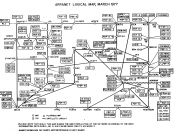IntroductionSince the advent of digital computing, ICT has attained astonishing breadth and depth in society generally and in organizations specifically. Global IT spending reached US$965 billion in 2004 and is expected to grow at a compounded annual rate of 6%, according to Gonsalves. The ubiquity of ICT can easily be taken for granted; e-mail, voice technologies, instant messaging, streaming video, digital audio players, and handheld messaging devices have become fixtures in daily life over the past two decades, with much of the technology transitioning from innovation to commodity in the past 10 years.
Significance of ICTKristula notes the significance of the 1957 launch of Sputnik, the first artificial earth satellite, in provoking the most profound societal application of ICT to date: the Internet. Launched by the Soviet Union to gain an advantage in the exploration (and subsequent militarization) of space, Sputnik shocked the American public with the possibility that the Soviets could launch ballistic missiles from a space-based platform.
In addition to escalating the pace of satellite development, the United States also formed its Advance Research Projects Agency in the Department of Defense to lead the development of innovative military technologies. One of these technologies, ARPANET, was conceived as a means to communicate without interruption during a nuclear attack, and its underlying concepts produced the commercial Internet. Begun in 1968, ARPANET enabled e-mail in 1972, listservs in 1979, the World Wide Web in 1992, and the online ordering of Pizza Hut pizza in 1994, as noted by Kristula in 1997. Most current applications of ICT make use of the Internet.
Innovation and progress in ICT are generally measured in size, capability, freedom of movement, and access. Among the significant recent advancements in ICT hardware are the steady replacement of desktop computers with laptops, more powerful processors, the near obsolescence...


